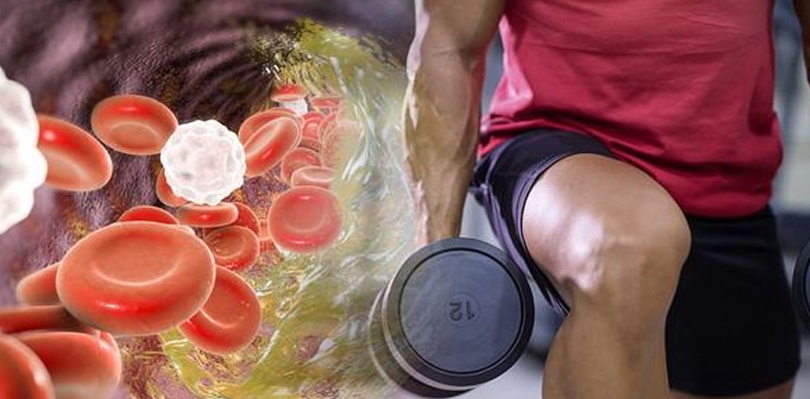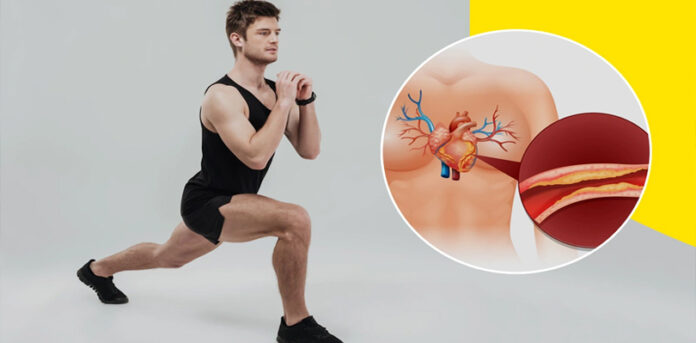Are you ready to take control of your health and embark on a journey towards better cardiovascular well-being? High cholesterol levels are a common concern in today’s fast-paced world, but the good news is that you can make a positive change. In this blog post, we’re going to dive deep into a topic that can transform your life: “Exercises To Lower High Cholesterol: Benefits And More.”
Cholesterol management is not just about medication; it’s about empowering yourself with the knowledge and tools to improve your health naturally. Discover how the right exercises can play a pivotal role in reducing your cholesterin levels, enhancing your overall fitness, and reducing your risk of heart disease. Get ready to unlock the secrets to a healthier, happier you, all while embracing an active lifestyle that brings vitality and longevity. Let’s get started!
Exercises To Lower High Cholesterol

Lowering high cholesterol through exercise is an effective and natural way to improve your cardiovascular health. Here are some exercises, that can help you achieve lower cholesterin levels:
Aerobic Exercises
Aerobic exercises like brisk walking, jogging, cycling, and swimming are excellent choices. They elevate your heart rate and help burn excess fat, including LDL (low-density lipoprotein) cholesterol. Aim for at least 150 minutes of moderate-intensity aerobic activity per week.
Strength Training
Building muscle through strength training exercises, such as weightlifting or bodyweight exercises like push-ups and squats, can help increase your metabolism. A higher metabolism aids in weight management, which, in turn, can lower cholesterol levels.
Yoga
Yoga not only improves flexibility and reduces stress but can also positively impact cholesterol levels. Certain yoga poses, such as forward bends and twists, can massage and stimulate abdominal organs, potentially aiding in better digestion and cholesterin regulation.
High-Intensity Interval Training (HIIT)
HIIT involves short bursts of intense exercise followed by brief periods of rest. This type of workout can improve your cardiovascular fitness, increase HDL (high-density lipoprotein) or “good” cholesterol, and lower triglycerides.
Tai Chi
Tai Chi is a gentle and low-impact exercise that focuses on balance and deep breathing. Regular practice can improve circulation and help manage cholesterol levels, particularly in older adults.
Hiking
Exploring the great outdoors through hiking not only provides cardiovascular benefits but also allows you to connect with nature and reduce stress. Studies suggest that spending time in nature can lower cholesterol levels.
Pilates
Pilates is an excellent choice for strengthening your core muscles and improving posture. A strong core can help you maintain an active lifestyle, making it easier to engage in other cholesterin-lowering exercises.
Remember that consistency is key when it comes to exercise and cholesterol management. Consult with a healthcare professional or fitness expert before starting any new exercise routine, especially if you have pre-existing medical conditions. Combined with a healthy diet and lifestyle, these exercises can help you achieve and maintain healthy cholesterin levels, reducing your risk of heart disease and other related health issues.
Benefits Of Doing Exercises To Lower High Cholesterol
Engaging in exercises to lower high cholesterol offers a wide range of benefits for your overall health and well-being. Here are some significant advantages:
Reduced LDL Cholesterol
Regular exercise helps lower LDL (low-density lipoprotein) cholesterol levels, which is often referred to as “bad” cholesterol. This reduction decreases the accumulation of plaque in your arteries, reducing the risk of atherosclerosis and related heart diseases.
Increased HDL Cholesterol
Exercise increases HDL (high-density lipoprotein) cholesterol, the “good” cholesterol. Higher HDL levels can help transport excess cholesterin away from your arteries and back to the liver for processing and removal from the body.
Weight Management
Exercise plays a crucial role in maintaining a healthy weight. Shedding excess pounds through physical activity can significantly lower your cholesterol levels, as being overweight or obese is often associated with higher cholesterol.
Improved Cardiovascular Health
Regular exercise strengthens your heart, enhances its efficiency, and lowers blood pressure. This combination of effects reduces the strain on your cardiovascular system and decreases the risk of heart disease.
Enhanced Insulin Sensitivity
Exercise helps improve insulin sensitivity, making it easier for your cells to use glucose for energy. This can help prevent or manage conditions like diabetes, which can contribute to high cholesterol.
Stress Reduction
Exercise is a natural stress reliever, triggering the release of endorphins that promote feelings of well-being. Managing stress is crucial because chronic stress can raise cholesterol levels and increase the risk of heart problems.
Incorporating exercises into your routine to lower high cholesterol not only addresses the root cause of the issue but also promotes overall health and vitality. Along with a balanced diet and other lifestyle modifications, regular physical activity can be a powerful tool in maintaining healthy cholesterin levels and reducing the risk of heart-related complications.
What Doctors Say About Exercising To Lower High Cholesterol
Doctors overwhelmingly recommend exercising to lower high cholesterol levels. Regular physical activity has a proven track record of positively impacting cholesterin profiles. It helps reduce LDL (bad) cholesterol, raise HDL (good) cholesterol, and improve overall cardiovascular health. Most doctors advise patients to aim for at least 150 minutes of moderate-intensity aerobic exercise per week, combined with strength training exercises.
This combination not only lowers cholesterol but also contributes to weight management, better blood pressure control, and reduced risk of heart disease. Doctors emphasize that exercise is a crucial component of a comprehensive approach to managing high cholesterin, complementing dietary changes and, in some cases, medication.
Tips And Techniques To Do Exercises To Lower High Cholesterol
Lowering high cholesterol through exercise requires a strategic approach to maximize its benefits. Here are a few tips and techniques with details to help you effectively manage your cholesterin levels:
Consult Your Healthcare Provider
Before starting any exercise regimen, consult your healthcare provider, especially if you have underlying medical conditions or are taking medication. They can provide personalized recommendations and ensure your exercise plan is safe and appropriate for your health status.
Set Realistic Goals
Establish achievable exercise goals that align with your current fitness level and cholesterin levels. Gradually increase the intensity and duration of your workouts to prevent burnout or injury. Start with manageable objectives and adjust them over time as your fitness improves.
Combine Cardiovascular And Strength Training
A balanced approach is key. Combine aerobic exercises like brisk walking, jogging, or cycling with strength training routines. Cardiovascular workouts enhance calorie burn and reduce LDL cholesterol, while strength training builds muscle, increases metabolism, and improves overall cardiovascular health.
Prioritize Regularity Over Intensity
Consistency is more critical than intense, sporadic workouts. Aim for regular exercise sessions throughout the week, as this helps maintain cholesterol benefits over the long term. Even moderate-intensity workouts, when done consistently, can lead to substantial improvements in cholesterin levels.
Include Variety and Enjoyment
Incorporate a variety of exercises to keep your routine engaging and prevent boredom. Consider activities like swimming, hiking, dancing, or team sports to make exercise enjoyable. When you look forward to your workouts, you’re more likely to stay committed and reap the cholesterol-lowering benefits.
Remember that lifestyle changes, including exercise, are most effective when combined with a heart-healthy diet and overall healthy living practices. Monitor your progress, track your cholesterin levels regularly with your healthcare provider, and adjust your exercise plan as needed to achieve and maintain optimal cholesterin levels and better cardiovascular health.
FAQs
How long does it take to see results from exercise in lowering high cholesterol levels?
The timeframe for seeing improvements through exercise can vary from person to person. In general, some individuals may start to notice changes in their cholesterol profiles within a few weeks of regular exercise. However, significant and sustained improvements often require several months of consistent effort. The exact duration depends on factors like your starting cholesterin levels, the intensity of your exercise routine, and your overall health. It’s crucial to remain patient and committed to long-term exercise for lasting benefits.
Can exercise alone lower cholesterol levels, or do I need to make dietary changes as well?
While exercise plays a vital role in improving cholesterol levels, it’s most effective when combined with a heart-healthy diet. Dietary modifications, such as reducing saturated and trans fats, increasing fiber intake, and incorporating foods like oats and nuts, complement the effects of exercise. The synergy between diet and exercise produces more substantial results in managing high. Consult with a healthcare provider or nutritionist to create a comprehensive plan tailored to your specific needs.
What is the ideal exercise routine for lowering high cholesterol, and how often should I exercise?
The ideal exercise routine for lowering high cholesterol consists of both aerobic (cardiovascular) and strength training exercises. Aim for at least 150 minutes of moderate-intensity aerobic activity per week, spread over several days. Additionally, include strength training exercises on two or more days per week. This combination enhances overall cardiovascular health, lowers LDL (bad) cholesterol, and increases HDL (good) cholesterol. It’s essential to find a balance that works for you and fits into your lifestyle. Consult with a healthcare provider or fitness expert to create a personalized exercise plan that considers your current fitness level and goals.

